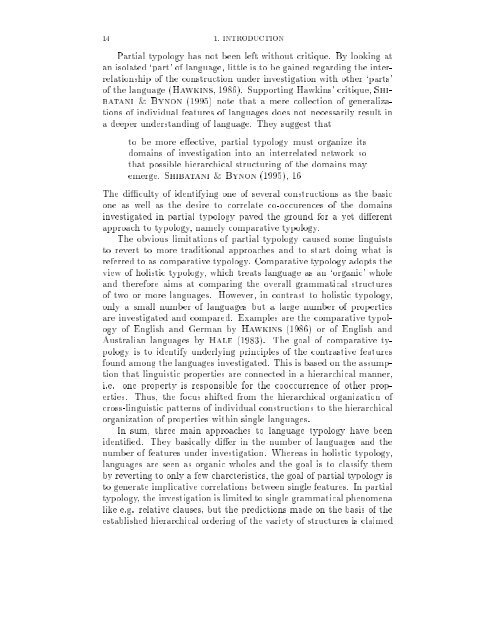Perception verb complements in Akatek, a Mayan language
Perception verb complements in Akatek, a Mayan language
Perception verb complements in Akatek, a Mayan language
You also want an ePaper? Increase the reach of your titles
YUMPU automatically turns print PDFs into web optimized ePapers that Google loves.
14 1. INTRODUCTION<br />
Partial typology has not been left without critique. By look<strong>in</strong>g at<br />
an isolated `part' of <strong>language</strong>, little is to be ga<strong>in</strong>ed regard<strong>in</strong>g the <strong>in</strong>terrelationship<br />
of the construction under <strong>in</strong>vestigation with other `parts'<br />
of the <strong>language</strong> (Hawk<strong>in</strong>s, 1986). Support<strong>in</strong>g Hawk<strong>in</strong>s' critique, Shibatani<br />
& Bynon (1995) note that a mere collection of generalizations<br />
of <strong>in</strong>dividual features of <strong>language</strong>s does not necessarily result <strong>in</strong><br />
a deeper understand<strong>in</strong>g of <strong>language</strong>. They suggest that<br />
to be more e ective, partial typology must organize its<br />
doma<strong>in</strong>s of <strong>in</strong>vestigation <strong>in</strong>to an <strong>in</strong>terrelated network so<br />
that possible hierarchical structur<strong>in</strong>g of the doma<strong>in</strong>s may<br />
emerge. Shibatani & Bynon (1995), 16<br />
The di culty of identify<strong>in</strong>g one of several constructions as the basic<br />
one as well as the desire to correlate co-occurences of the doma<strong>in</strong>s<br />
<strong>in</strong>vestigated <strong>in</strong> partial typology paved the ground for a yet di erent<br />
approach totypology, namely comparative typology.<br />
The obvious limitations of partial typology caused some l<strong>in</strong>guists<br />
to revert to more traditional approaches and to start do<strong>in</strong>g what is<br />
referred to as comparative typology. Comparative typology adopts the<br />
view of holistic typology, which treats <strong>language</strong> as an `organic' whole<br />
and therefore aims at compar<strong>in</strong>g the overall grammatical structures<br />
of two or more <strong>language</strong>s. However, <strong>in</strong> contrast to holistic typology,<br />
only a small number of <strong>language</strong>s but a large number of properties<br />
are <strong>in</strong>vestigated and compared. Examples are the comparative typology<br />
of English and German by Hawk<strong>in</strong>s (1986) or of English and<br />
Australian <strong>language</strong>s by Hale (1983). The goal of comparative typology<br />
is to identify underly<strong>in</strong>g pr<strong>in</strong>ciples of the contrastive features<br />
found among the <strong>language</strong>s <strong>in</strong>vestigated. This is based on the assumption<br />
that l<strong>in</strong>guistic properties are connected <strong>in</strong> a hierarchical manner,<br />
i.e. one property is responsible for the cooccurrence of other properties.<br />
Thus, the focus shifted from the hierarchical organization of<br />
cross-l<strong>in</strong>guistic patterns of <strong>in</strong>dividual constructions to the hierarchical<br />
organization of properties with<strong>in</strong> s<strong>in</strong>gle <strong>language</strong>s.<br />
In sum, three ma<strong>in</strong> approaches to <strong>language</strong> typology have been<br />
identi ed. They basically di er <strong>in</strong> the number of <strong>language</strong>s and the<br />
number of features under <strong>in</strong>vestigation. Whereas <strong>in</strong> holistic typology,<br />
<strong>language</strong>s are seen as organic wholes and the goal is to classify them<br />
by revert<strong>in</strong>g to only a few charcteristics, the goal of partial typology is<br />
to generate implicative correlations between s<strong>in</strong>gle features. In partial<br />
typology, the <strong>in</strong>vestigation is limited to s<strong>in</strong>gle grammatical phenomena<br />
like e.g. relative clauses, but the predictions made on the basis of the<br />
established hierarchical order<strong>in</strong>g of the variety of structures is claimed

















